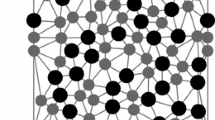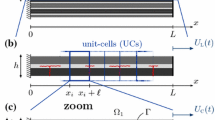Abstract
Fracture of three-dimensional unidirectional composites is studied through Monte Carlo fracture simulations on model composites. Fracture develops in the model composites by the failure of fibre segments wherein the tensile stress exceeds a Weibull-distributed random strength, and by the failure of the fibre–matrix interfaces wherein the shear stress exceeds a deterministic interfacial strength, \(T_0\). The size of the weakest-link failure event is inferred from empirical strength distributions obtained from the simulations. It is found to diverge or converge with composite size for \(T_0\) below or above a threshold value, respectively. The threshold is identified as the tough–brittle fracture mode transition. The mechanistic cause underlying the transition is also identified.























Similar content being viewed by others
References
Banholzer B, Brameshuber W (2001) Eine methode zur beschreibung des verbundes zwischen faser und zementgebundener matrix. Beton Stahlbetonbau 96(10):663–669
Beyerlein IJ, Phoenix SL (1997) Statistics of fracture for an elastic notched composite lamina containing Weibull fibers I. Features from Monte-Carlo simulation. Eng Fract Mech 57(2–3):241–265
Binder K (2003) Overcoming the limitation of finite size in simulations: From the phase transition of the Ising model to polymers, spin glasses, etc. In: AIP conference proceedings, vol 690. American Institute of Physics, pp 74–84
Cook J, Gordon J (1964) A mechanism for the control of crack propagation in all-brittle systems. Proc R Soc Lond A 282(1391):508–520
Curtin W (1993) The tough to brittle transition in brittle matrix composites. J Mech Phys Solids 41(2):217–245
Curtin W (1998) Size scaling of strength in heterogeneous materials. Phys Rev Lett 80(7):1445
Curtin W (2000) Dimensionality and size effects on the strength of fiber-reinforced composites. Compos Sci Technol 60(4):543–551
Daniels HE (1945) The statistical theory of the strength of bundles of threads. Proc R Soc Lond A 183(995):405–435
Dzenis YA, Qian J (2001) Analysis of microdamage evolution histories in composites. Int J Solids Struct 38(10–13):1831–1854
Epstein B (1948) Statistical aspects of fracture problems. J Appl Phys 19(2):140–147
Goree JG, Gross RS (1980) Analysis of a unidirectional composite containing broken fibers and matrix damage. Eng Fract Mech 13(3):563–578
Gücer D, Gurland J (1962) Comparison of the statistics of two fracture modes. J Mech Phys Solids 10(4):365–373
Gupta A, Mahesh S, Keralavarma SM (2017) Strength distribution of large unidirectional composite patches with realistic load sharing. Phys Rev E 96(4):043002
Gupta A, Mahesh S, Keralavarma SM (2018) A fast algorithm for the elastic fields due to interacting fibre breaks in a periodic fibre composite. Int J Fract 211(1–2):295–303
Habeeb CI, Mahesh S (2015) Strength distribution of planar local load-sharing bundles. Phys Rev E 92(2):022125
Hansen A, Hemmer P, Pradhan S (2015) The fiber bundle model: modeling failure in materials. Statistical physics of fracture and breakdown. Wiley
Harlow DG, Phoenix S (1981a) Probability distributions for the strength of composite materials I: two-level bounds. Int J Fract 17(4):347–372
Harlow DG, Phoenix SL (1981b) Probability distributions for the strength of composite materials II: a convergent sequence of tight bounds. Int J Fract 17(6):601–630
He M, Evans AG, Curtin WA (1993) The ultimate tensile strength of metal and ceramic-matrix composites. Acta Metall Mater 41(3):871–878
Hedgepeth JM (1961) Stress concentrations in filamentary structures. Tech. Rep. RN D-882, NASA
Hedgepeth JM, Van Dyke P (1967) Local stress concentrations in imperfect filamentary composite materials. J Compos Mater 1(3):294–309
Herrera-Franco P, Drzal L (1992) Comparison of methods for the measurement of fibre/matrix adhesion in composites. Composites A 23(1):2–27
Hull D, Clyne TW (1996) An introduction to composite materials. Cambridge University Press, Cambridge
Ibnabdeljalil M, Curtin W (1997) Strength and reliability of fiber-reinforced composites: localized load-sharing and associated size effects. Int J Solids Struct 34(21):2649–2668
Ibnabdeljalil M, Curtin W (1997) Strength and reliability of notched fiber-reinforced composites. Acta Mater 45(9):3641–3652
Kachhwah US, Mahesh S (2020) Tough-brittle transition in the planar fracture of unidirectional fiber composites. Phys Rev E 101(6):063002
Karger-Kocsis J, Mahmood H, Pegoretti A (2015) Recent advances in fiber/matrix interphase engineering for polymer composites. Prog Mater Sci 73:1–43
Kumar MS, Raghavendra K, Venkataswamy MA, Ramachandra HV (2012) Fractographic analysis of tensile failures of aerospace grade composites. Mater Res 15(6):990–997
Landis CM, Beyerlein IJ, McMeeking RM (2000) Micromechanical simulation of the failure of fiber reinforced composites. J Mech Phys Solids 48(3):621–648
Ma Y, Yang Y, Sugahara T, Hamada H (2016) A study on the failure behavior and mechanical properties of unidirectional fiber reinforced thermosetting and thermoplastic composites. Composites B 99:162–172
Ma Y, Ueda M, Yokozeki T, Sugahara T, Yang Y, Hamada H (2017) A comparative study of the mechanical properties and failure behavior of carbon fiber/epoxy and carbon fiber/polyamide 6 unidirectional composites. Compos Struct 160:89–99
Mahesh S (2020) A fast algorithm for fracture simulations representing fibre breakage and matrix failure in three-dimensional fibre composites. Int J Fract 222(1):75–109
Mahesh S, Phoenix SL, Beyerlein IJ (2002) Strength distributions and size effects for 2D and 3D composites with Weibull fibers in an elastic matrix. Int J Fract 115(1):41–85
Mahesh S, Gupta A, Kachhwah US, Sheikh N (2019) A fast algorithm to simulate the failure of a periodic elastic fibre composite. Int J Fract 217(1):127–135
McCartney L, Smith R (1983) Statistical theory of the strength of fiber bundles. J Appl Mech 50(3):601–608
Nishimori H, Ortiz G (2010) Elements of phase transitions and critical phenomena. OUP, Oxford
Robinson P, Greenhalgh E, Pinho S (2012) Failure mechanisms in polymer matrix composites: criteria, testing and industrial applications. Elsevier, London
Scott A, Mavrogordato M, Wright P, Sinclair I, Spearing S (2011) In situ fibre fracture measurement in carbon-epoxy laminates using high resolution computed tomography. Compos Sci Technol 71(12):1471–1477
Sket F, Seltzer R, Molina-Aldareguía J, Gonzalez C, LLorca J (2012) Determination of damage micromechanisms and fracture resistance of glass fiber/epoxy cross-ply laminate by means of x-ray computed microtomography. Compos Sci Technol 72(2):350–359
Smith R (1980) A probability model for fibrous composites with local load sharing. Proc R Soc Lond A 372(1751):539–553
Smith R, Phoenix S, Greenfield M, Henstenburg R, Pitt R (1983) Lower-tail approximations for the probability of failure of three-dimensional fibrous composites with hexagonal geometry. Proc R Soc Lond A 388(1795):353-391
Weibull W (1952) A statistical distribution function of wide applicability. J Appl Mech 19(2):233–234
Zhandarov S, Mäder E (2005) Characterization of fiber/matrix interface strength: applicability of different tests, approaches and parameters. Compos Sci Technol 65(1):149–160
Author information
Authors and Affiliations
Corresponding author
Additional information
Publisher's Note
Springer Nature remains neutral with regard to jurisdictional claims in published maps and institutional affiliations.
Rights and permissions
About this article
Cite this article
Mahesh, S. Tough–brittle transition in unidirectional composites with fibre breakage and fibre–matrix interfacial failure. Int J Fract 233, 39–70 (2022). https://doi.org/10.1007/s10704-021-00609-9
Received:
Accepted:
Published:
Issue Date:
DOI: https://doi.org/10.1007/s10704-021-00609-9




